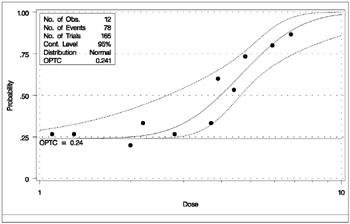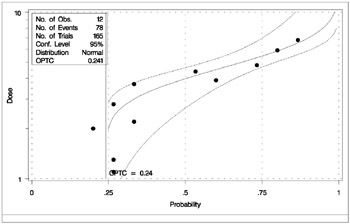Getting Started
The following example illustrates how you can use the PROBIT procedure to compute the threshold response rate and regression parameter estimates for quantal response data.
Estimating the Natural Response Threshold Parameter
Suppose you want to test the effect of a drug at 12 dosage levels. You randomly divide 180 subjects into 12 groups of 15 ”one group for each dosage level. You then conduct the experiment and, for each subject, record the presence or absence of a positive response to the drug. You summarize the data by counting the number of subjects responding positively in each dose group . Your data set is as follows :
data study; input Dose Respond; Number = 15; datalines; 0 3 1.1 4 1.3 4 2.0 3 2.2 5 2.8 4 3.7 5 3.9 9 4.4 8 4.8 11 5.9 12 6.8 13 ; run;
The variable dose represents the amount of drug administered. The first group, receiving a dose level of 0, is the control group. The variable number represents the number of subjects in each group. All groups are equal in size ; hence, number has the value 15 for all observations. The variable respond represents the number of subjects responding to the associated drug dosage.
You can model the probability of positive response as a function of dosage using the following statements:
proc probit data=study log10 optc; model respond/number=dose; output out = new p = p_hat; predpplot var = dose cfit = blue cframe=ligr inborder; inset; ippplot var = dose cfit = blue cframe=ligr inborder; inset; run;
The DATA= option specifies that PROC PROBIT analyze the SAS data set study . The LOG10 option replaces the first continuous independent variable ( dose ) by its common logarithm. The OPTC option estimates the natural response rate. When you use the LOG10 option with the OPTC option, any observations with a dose value less than or equal to zero are used in the estimation as a control group.
The OUTPUT statement creates a new data set, new , that contains all the variables in the original data set, and a new variable, p_ hat , that represents the predicted probabilities.
The MODEL statement specifies a proportional response using the variables respond and number in events/trials syntax. The variable dose is the stimulus or explanatory variable. The results from this analysis are displayed in the following figures.
Figure 60.1 displays background information about the model fit. Included are the name of the input data set, the response variables used, and the number of observations, events, and trials. The last line in Figure 60.1 shows the final value of the log- likelihood function.
| |
Probit Procedure Model Information Data Set WORK.STUDY Events Variable Respond Trials Variable Number Number of Observations 12 Number of Events 81 Number of Trials 180 Number of Events In Control Group 3 Number of Trials In Control Group 15 Name of Distribution Normal Log Likelihood 104.3945783 Algorithm converged.
| |
Figure 60.1: Model Fitting Information for the PROBIT Procedure
| |
Probit Procedure Analysis of Parameter Estimates Standard 95% Confidence Chi Parameter DF Estimate Error Limits Square Pr > ChiSq Intercept 1 4.1438 1.3415 6.7731 1.5146 9.54 0.0020 Log10(Dose) 1 6.2308 1.8996 2.5076 9.9539 10.76 0.0010 _C_ 1 0.2409 0.0523 0.1385 0.3433
| |
Figure 60.2: Model Parameter Estimates for the PROBIT Procedure
as
where is the normal cumulative distribution function.
Finally, PROC PROBIT specifies the resulting tolerance distribution by providing the mean MU and scale parameter SIGMA as well as the covariance matrix of the distribution parameters.
| |
Probit Procedure Probit Model in Terms of Tolerance Distribution MU SIGMA 0.66506312 0.16049411 Estimated Covariance Matrix for Tolerance Parameters MU SIGMA _C_ MU 0.001158 0.000493 0.000954 SIGMA 0.000493 0.002394 0.000999 _C_ 0.000954 0.000999 0.002731
| |
Figure 60.3: Tolerance Distribution Estimates for the PROBIT Procedure
The PREDPPLOT statement creates the plot in Figure 60.4, showing the relationship between dosage level, observed response proportions , and estimated probability values. The dashed lines represent pointwise confidence bands for the fitted probabilities, and a reference line is plotted at the estimated threshold value of .24.

Figure 60.4: Plot of Observed and Fitted Probabilities versus Dose Level
The IPPPLOT statement creates the plot in Figure 60.5, showing the inverse relationship between dosage level and observed response proportions/estimated probability values. The dashed lines represent pointwise fiducial limits for the predicted values of the dose variable, and a reference line is also plotted at the estimated threshold value of .24.

Figure 60.5: Inverse Predicted Probability Plot with Fiducial Limits
The INSET statement after each of these plot statements draws a box within the plot. In the inset box, summary information about the model fitting is printed.